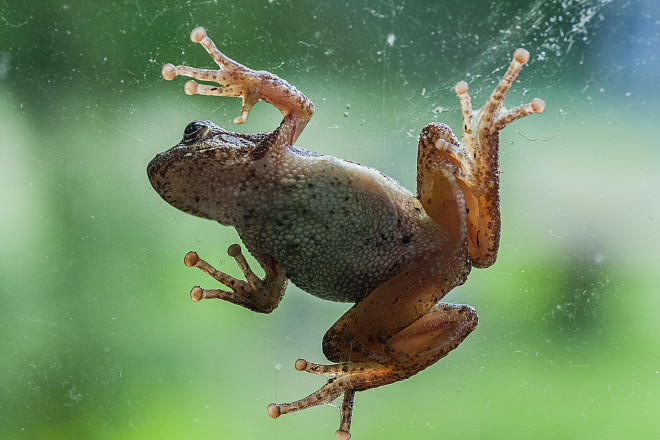Welcoming Spring “Peepers”
- Share
- Tweet
- Pin
- Share

It really isn’t spring until we hear the peeping choruses of tiny frogs, which, for obvious reasons, are called spring peepers. That usually happens around Good Friday, an odd coincidence because the species name for forest dwelling frog is “crucifer.”
Because early scientists often had strong religious affiliations, the name probably refers to the distinct black cross marking on a peeper’s back. But the way these frogs overwinter in a frozen state and then come alive again in spring does seem miraculous.
Spring peeper toes are like suction cups. Consequently, they cannot dig all that well so when fall comes, they simply burrow under a log or dead leaves. But it’s freezing in winter. True, but just before the frogs go into hibernation, their metabolisms kick into high gear, enabling them to produce and concentrate sugars and sugar alcohols, creating what amounts to anti-freeze. Apparently the concentrated sugars keep the contents of cells from freezing and prevent ice crystals (which would rupture cell walls) from forming.
During deep winter, the body fluids of spring peepers are frozen solid. The hibernating frogs stop breathing and their little frog hearts actually stop beating, but their vital organs do not fully freeze so they aren’t dead. In fact, as soon as they thaw, they are very much alive.
When spring thaw melts the ice, the tiny peepers (and they are tiny, about an inch from snout to vent) make their way to their breeding ponds. The ideal ponds are the temporary snowmelt ponds in lowland forests and wetlands, or ponds that dry out in the summer and fall. Bodies of water that cannot support fish are perfect for frogs and tadpoles.
Often these ponds are some distance from the forest habitats of spring peepers, so little frogs require wildlife corridors to migrate from their woodland homes to breeding ponds. Because peepers make their mass migrations after dark, humans rarely notice them until they start peeping.
Male peepers peep (and sometimes trill) to keep other males out of their tiny breeding territories, but the primary reason for the “singing” is to attract a female.
To sing, a male frog forces air between his lungs and mouth. The air produces sound vibrations as it passes through the vocal chords, but the sounds are greatly amplified by the puffed up throat.
When the frog exhales, the vocal sac looks like a deflated bagpipe. But an amorous male just re-inflates and peeps some more.
If a female frog hears the evening frog chorus (and how could she not?) and if she detects the unique song of her species and is in breeding condition, she selects the most desirable male and initiates courtship.
What makes the peep of one frog more desirable than another? Length or pitch of peep? Volume ? Overtones? Stamina? I have no idea, but apparently female peepers know exactly what they are listening for.
Around our peninsula, depending on weather of course, spring peepers peep from sunset till about midnight from late March through early June. They do their most enthusiastic peeping when the air temperatures are between 55 and 70 degrees Fahrenheit. Gentle rains seems to be an aphrodisiac.
As the snow melts and the forests fill with ephemeral ponds, another miracle is happening. Spring peepers are thawing and coming alive. And when they begin peeping, it really is spring.
Coggin Heeringa is the Director of Crossroads at Big Creek and Instructor of Environmental Studies at the Interlochen Arts Camp.



